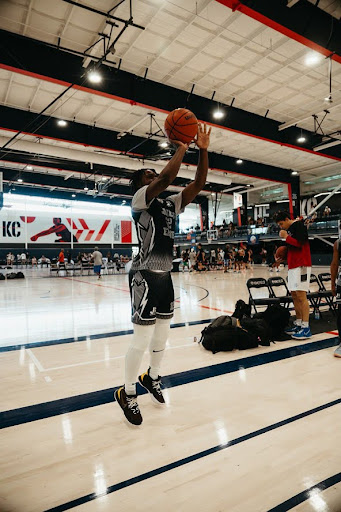Of the familiar sounds of basketball — chests heaving, shoes squeaking, net swishing and buzzer ringing — money talks the loudest.
Outside of school sports, there are plenty of options for young athletes to continue their practice. Each sport has its own system for playing outside of school-sanctioned teams; sports like volleyball and soccer have competitive “club” teams, and track and basketball have teams through the Amateur Athletic Union (AAU). The AAU consists of locally made teams that play in tournaments, but behind there are different levels of play.
“School basketball is way more organized and fundamental,” Ethan McCreight (11), a basketball player at White Station High School (WSHS), said. “Some AAU teams don’t even practice.”
School sports are about more than just winning games and tournaments. Individual talent is emphasized alongside learning how to succeed as a team. By contrast, AAU and most non-school sanctioned sports place emphasis on solely victory. Instead of recruiting players with potential, many AAU coaches will search for players who they already deem to be skillful enough to win games. This way, athletes and coaches gain more exposure, which is a large reason why people join said teams.
“AAU can sometimes be just stacking teams up,” McCreight said. “You can pay hundreds to join a team and only play in a few games.”
Nike’s Elite Youth Basketball League (EYBL) is the most competitive group of AAU teams. These teams compete with other high-caliber teams from across the country and get vast social media coverage. AAU’s tournament footage on social media has helped launch the careers of many new and upcoming NBA players. Many believe EYBL is the only AAU circuit worth joining, and that many other leagues just exist for financial profit.
“[AAU] is very much a money grab,” Coach Quinton Johnson said. “What exposure are most players really getting?”
Many players find themselves on EYBL teams through connections — connections that wealthier players have greater access to. Of course, talent and skill are heavily considered, but usually a player has to know someone to gain leverage in the portal. Of course, parents with past experience in college and the NBA have a much easier time creating opportunities for their children. Top coaches and recruiters are rarely part of the lower class, though, so lower class players will rarely have connections to use.
“That’s what EYBL is: connections,” McCreight said. “‘My dad knows this coach, so he can get me into this.’”
Even if a player had the talent, skill and connections to join an EYBL or other high circuit AAU team, they may not have the funds for it. Team fees, tournament fees and constant traveling have made basketball the second-most-expensive youth sport, according to The Aspen Institute. It now costs $1000-2000+ to play on a competitive or elite AAU basketball team, according to Huff Sports.
“My first year playing AAU cost me $2000,” McCreight said. “I played for Memphis Swarm.”
After youth basketball, players may look to play in college. As a result of new videography technology, scouts spend less time physically at games and more time reviewing footage that players send to potential colleges. Not all schools have the funds to record every game, but most AAU teams do. Not only does this disadvantage lower income players, but the college portal does as well. Since scouts can take on players who have already played at the collegiate level, they are less likely to recruit high school athletes. This difference means that less full-ride scholarships are available for the high school athletes that depend on them.
“Freshmen have to learn,” Marcus Nunnally, the director of scouting for the University of Memphis’s men’s basketball team, said. “It’s easier to get guys who already know how to play at [the collegiate level].”
Many would consider an athlete’s come-up story as one of the best parts of being a fan of a sport. “Rags-to-riches” stories are notoriously fan favorites, but basketball seems to lack them lately. Lebron James, regarded as one of the best NBA players of all time, is adored by many for finding success after his financially struggling childhood in Akron, Ohio. Fast forward 21 years after his NBA draft, his son, Bronny, has been drafted in 2024. Due to James’s success, Bronny never had to struggle financially, along with most players in his draft class. According to ESPN’s “Importance of an Athlete’s Background,” athletes in the lower class have a 37% less likelihood of making it to the NBA.
“I didn’t become a singular player fan until Lebron showed up,” Johnson said. “I’ve been following him since high school.”
Young athletes in the lower economic bracket in America have both AAU costs and fewer college scholarships stacked against their professional play dreams. These players are increasingly left out of the continually evolving sport as they are hit against a defeating reality: the American Dream comes with a hefty price tag.
“There’s a lot of talented kids in poor areas who just can’t get onto good teams,” Nunnally said. “Your money matters because you need to be able to afford a trainer and travel.”





































